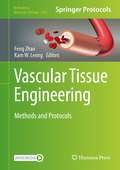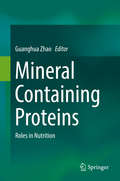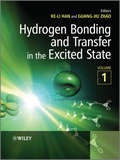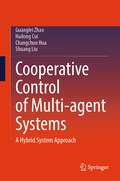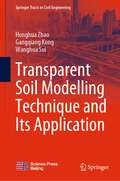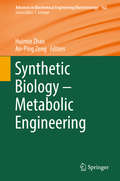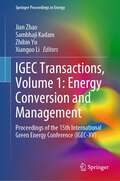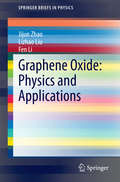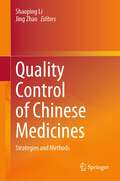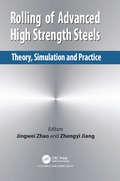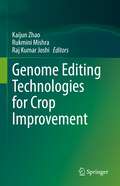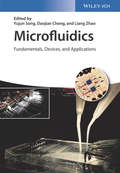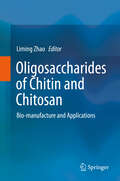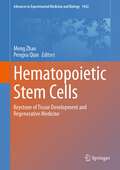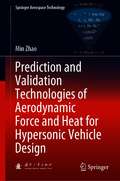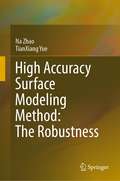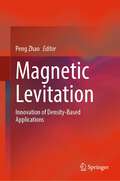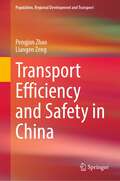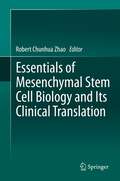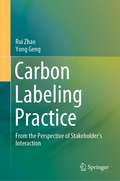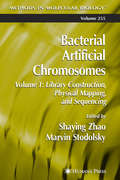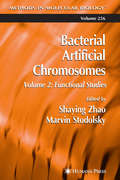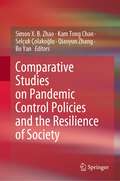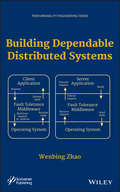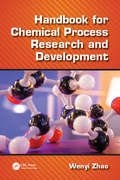- Table View
- List View
Vascular Tissue Engineering: Methods and Protocols (Methods in Molecular Biology #2375)
by Feng Zhao Kam W. LeongThis volume explores the latest techniques used to study the field of tissue engineered vascular grafts (TEVGs). The chapters in this book cover a wide array of topics such as deriving vascular cells from monocytes and induced pluripotent stem cells; engineering vascular grafts using various biomaterials and stem cells, stem cell-derived, or primary vascular cells; biomaterial modification by anticoagulation molecules; vascular bioengineering technologies such as 3D bioprinting; and fabrication of TEVGs with different geometry and multiphase structures. This book also features protocols for grafting and evaluation of vascular grafts in animal models, vascular imaging in animals, and the quantification of blood vessel permeability. Written in the highly successful Methods in Molecular Biology series format, chapters include introductions to their respective topics, lists of the necessary materials and reagents, step-by-step, readily reproducible laboratory protocols, and tips on troubleshooting and avoiding known pitfalls. Cutting-edge and practical, Vascular Tissue Engineering: Methods and Protocols is a valuable resource for biomedical engineers, cell biologists, vascular surgeons, doctors, and nurses.
Mineral Containing Proteins
by Guanghua ZhaoThis book describes the structure, function and nutritional values of iron-, zinc-, selenium- and calcium-containing proteins, exploring key mineral-containing proteins like phytoferritin and lactoferrin, as well as a host of zinc- and selenium-containing proteins. Due to their role in numerous metabolic processes, minerals such as calcium, iron, zinc and selenium are vital, and have to be obtained from a balanced diet because they cannot be synthesized. The structure and function of mineral-containing proteins influences the absorption of these essential minerals. As such, the study of these proteins is crucial for the assessment and maintenance of a balanced diet and for the development of effective mineral supplements. The book's closing chapters focus on issues arising from current food processing techniques and in the development of mineral supplements. The book offers a valuable guide for researchers and students in the fields of food chemistry and nutrition.
Hydrogen Bonding and Transfer in the Excited State
by Guang-Jiu Zhao Ke-Li HanThis book gives an extensive description of the state-of-the-art in research on excited-state hydrogen bonding and hydrogen transfer in recent years.Initial chapters present both the experimental and theoretical investigations on the excited-state hydrogen bonding structures and dynamics of many organic and biological chromophores. Following this, several chapters describe the influences of the excited-state hydrogen bonding on various photophysical processes and photochemical reactions, for example: hydrogen bonding effects on fluorescence emission behaviors and photoisomerization; the role of hydrogen bonding in photosynthetic water splitting; photoinduced electron transfer and solvation dynamics in room temperature ionic liquids; and hydrogen bonding barrier crossing dynamics at bio-mimicking surfaces. Finally, the book examines experimental and theoretical studies on the nature and control of excited-state hydrogen transfer in various systems.Hydrogen Bonding and Transfer in the Excited State is an essential overview of this increasingly important field of study, surveying the entire field over 2 volumes, 40 chapters and 1200 pages. It will find a place on the bookshelves of researchers in photochemistry, photobiology, photophysics, physical chemistry and chemical physics.
Cooperative Control of Multi-agent Systems: A Hybrid System Approach
by Guanglei Zhao Hailong Cui Changchun Hua Shuang LiuThis book focuses on stability analysis and control design approaches for multi-agent systems under network-induced constraints. A hybrid system approach is introduced to address the cooperative control problem of networked multi-agent systems, and several important topics such as asynchronous sampled data cooperative control, hybrid event-triggered cooperative control, and reset-based cooperative control are studied under the hybrid system framework. The special feature of this book is that a hybrid systems approach is proposed for the cooperative control of multi-agent systems, which is beneficial for relaxing the conservativeness of stability analysis and network parameter computation. Interested readers can learn a novel approach to cooperative control of multi-agent systems, and this book can benefit researchers, engineers, and graduate students in the fields of multi-robot cooperation, unmanned aerial vehicle formation, control engineering, etc.
Transparent Soil Modelling Technique and Its Application (Springer Tracts in Civil Engineering)
by Honghua Zhao Gangqiang Kong Wanghua SuiThis book systematically introduces the advancement of transparent soil modelling technique and its application. The transparent soil modelling technique provides an essential tool for visualizing soil-structure interaction and other geotechnical problems such as grouting, soil plugging. The geotechnical properties of the newest transparent soils were reported on model sand, clay and rock. In addition, more advanced image processing methods were summarized. In this book, numerous applications of transparent soil modelling techniques for different geotechnical problems were presented, and the results obtained are supplemented by numerical calculation and theoretical analysis.
Synthetic Biology – Metabolic Engineering
by Huimin Zhao An-Ping ZengThis book review series presents current trends in modern biotechnology. The aim is to cover all aspects of this interdisciplinary technology where knowledge, methods and expertise are required from chemistry, biochemistry, microbiology, genetics, chemical engineering and computer science. Volumes are organized topically and provide a comprehensive discussion of developments in the respective field over the past 3-5 years. The series also discusses new discoveries and applications. Special volumes are dedicated to selected topics which focus on new biotechnological products and new processes for their synthesis and purification. In general, special volumes are edited by well-known guest editors. The series editor and publisher will however always be pleased to receive suggestions and supplementary information. Manuscripts are accepted in English.
IGEC Transactions, Volume 1: Proceedings of the 15th International Green Energy Conference (IGEC-XV) (Springer Proceedings in Energy)
by Jian Zhao Sambhaji Kadam Zhibin Yu Xianguo LiThis book is the first volume of the proceedings of the 15th International Green Energy Conference (IGEC) held in Glasgow, UK from 10-13 July 2023. This meeting is the latest in a multi-disciplinary international conference series on the use of energy with no or reduced environmental, social, and economic impacts. The conference provided a platform for sharing new technical information, disseminating high-quality research results, presenting the latest developments in energy and environment, and debating the shaping of future directions and priorities for sustainable development and energy security.This conference proceedings is of particular value and interest to researchers, scientists, engineers, and practitioners from relevant fields of energy and environment, from policy-making and technical development to management and marketing.
Graphene Oxide: Physics and Applications
by Jijun Zhao Lizhao Liu Fen LiThis book gives a comprehensive overview of graphene oxides (GO) from atomic structures and fundamental properties to technological applications. Atomic structural models, electronic properties, mechanical properties, optical properties, and functionalizing and compositing of GO are illustrated. Moreover, the excellent physical and chemical properties offer GO promising applications in electronic nanodevices, chemical sensors and catalyst, energy storage, and biotechnology, which are also presented in this book. Therefore, this book is of interest to researchers in physics, chemistry, materials science, and nanoscience.
Quality Control of Chinese Medicines: Strategies and Methods
by Jing Zhao Shaoping LiThis book focuses on the strategies and methods for quality control of Chinese medicines used in prevention and treatment of diseases for thousands of years in China and East Asia. It explains various strategies and methods for quality markers discovery and herbal glycoanalysis, as well as practices for control of heavy metal and pesticide residues. Strategies to overcome the shortage of reference compounds for quality control of Chinese medicines are also provided. The book also introduces analytical techniques for different analytes in Chinese medicines with an emphasis on sample preparation in automation and high extraction efficiency methods, the key process affecting the time and accuracy of the techniques. It is of interest to quality control scientists in academia and industry working on Chinese medicines and/or herbal medicine and also pharmacists, pharmacologists, food chemists, and nutritionists who want to understand Chinese medicines.
Rolling of Advanced High Strength Steels: Theory, Simulation and Practice
by Jingwei Zhao Zhengyi JiangAdvanced high strength steels (AHSSs) for auto-making are primarily produced by rolling, plus heat treatment technologies if necessary. However, due to the metallurgical complexity of AHSSs, it is impossible to roll all of the AHSS grades in a rolling mill with the same rolling technology. Each of AHSSs has unique applications in vehicles, and specified rolling technologies are required to produce high quality AHSS products where they might be the best employed to meet performance demands of the automotive parts. Such background has prompted the publication of this scholarly book in the area of rolling of AHSSs with a purpose of providing readers with a valuable technical document that can be used in the research and development of AHSSs for automotive and other manufacturing industries. With contributors from USA, Germany, Poland, Italy, Spain, Austria, Australia, China, India and Iran, the book highlights the latest advances in rolling technologies of AHSSs. It focuses on the theory, simulation and practice of the rolling of AHSSs: The book introduces the history, types and advances of AHSSs and their processes; proposes new theory that is applicable to the rolling of AHSSs, presents mathematical and numerical modelling of AHSSs in rolling; covers thermomechanical processing technologies of AHSSs; provides case studies on the rolling practice of the most popular AHSSs and includes other rolling-related technologies of AHSSs. The book will be useful for both theoretical and applied research aimed at AHSSs rolling technologies, and will be a scientific and valuable literature for the metallurgists, engineers, materials scientists, academics and graduate students who are studying and working with AHSSs and their rolling technologies worldwide.
Genome Editing Technologies for Crop Improvement
by Kaijun Zhao Rukmini Mishra Raj Kumar JoshiThis book compiles the relevant information related to genome editing tools and their roles in crop improvement. The book contains a brief introduction about various genome editing tools and their application in major crops. It discusses the genome editing approaches and the strategies used for genome editing in different crops. Some of the chapters cover the detailed methodology of sgRNA design, vector construction and transformation in different crops followed by data analysis. A few chapters focus on the applications of genome editing tools towards crop improvement. This book will be of particular interest to plant biologists working in the field of genome editing and crop breeders. It will provide valuable information and useful material for our readers’ experimental work.
Microfluidics: Fundamentals, Devices, and Applications
by Liang Zhao Yujun Song Daojian ChengThe first book offering a global overview of fundamental microfluidics and the wide range of possible applications, for example, in chemistry, biology, and biomedical science. As such, it summarizes recent progress in microfluidics, including its origin and development, the theoretical fundamentals, and fabrication techniques for microfluidic devices. The book also comprehensively covers the fluid mechanics, physics and chemistry as well as applications in such different fields as detection and synthesis of inorganic and organic materials. A useful reference for non-specialists and a basic guideline for research scientists and technicians already active in this field or intending to work in microfluidics.
Oligosaccharides of Chitin and Chitosan: Bio-manufacture and Applications
by Liming ZhaoThe book provides an overview of bio-manufacturing techniques for the production, purification, characterization and modification of chito/chitin oligosaccharides and their monomers. In addition, it explores potential applications in the food, biomedical and agricultural industry on the basis of their bioactivities and biomaterial properties. Lastly, it shares a range of cutting-edge insights to help solve problems in industrial processes and promote further academic investigation. Given its scope, it offers a valuable resource for researchers and graduate students in the fields of bioengineering, food science, biochemistry, etc.
Hematopoietic Stem Cells: Keystone of Tissue Development and Regenerative Medicine (Advances in Experimental Medicine and Biology #1442)
by Meng Zhao Pengxu QianThis book renders a comprehensive understanding of hematopoietic stem cells (HSCs) from their embryonic development through adult maintenance to aging, in the studies conducted in zebrafish and mammals. Hematopoiesis provides a paradigm for understanding the development, maintenance, regeneration, aging and malignant transformation of mammalian organs. Sitting at the apex of the hematopoiesis hierarchy tree, HSCs orchestrate their proliferation, self-renewal, and differentiation to produce all the blood cell lineages throughout life, which represents the best example for somatic stem cell studies. In this book, key regulatory mechanisms for HSC self-renewal and differentiation are overviewed in an array of fields including epigenetics, metabolism and microenvironment regulation. It also highlights the HSC heterogeneity and clonal dynamics from the recent advanced single-cell technologies. This book elaborates on the research history of HSC studies and reveals how the insights from HSC studies shed light on their clinic application. It presents great value from the bench to the clinic.
Prediction and Validation Technologies of Aerodynamic Force and Heat for Hypersonic Vehicle Design (Springer Aerospace Technology)
by Min ZhaoThis book provides an overview of advanced prediction and verification technologies for aerodynamics and aerothermodynamics and assesses a number of critical issues in advanced hypersonic vehicle design. Focusing on state-of-the-art theories and promising technologies for engineering applications, it also presents a range of representative practical test cases. Given its scope, the book offers a valuable asset for researchers who are interested in thermodynamics, aircraft design, wind tunnel testing, fluid dynamics and aerothermodynamics research methods, introducing them to inspiring new research topics.
High Accuracy Surface Modeling Method: The Robustness
by Na Zhao TianXiang YueThis book focuses on the robustness analysis of high accuracy surface modeling method (HASM) to yield good performance of it. Understanding the sensitivity and uncertainty is important in model applications. The book aims to advance an integral framework for assessing model error that can demonstrate robustness across sets of possible controls, variable definitions, standard error, algorithm structure, and functional forms. It is an essential reference to the most promising numerical models. In areas where there is less certainty about models, but also high expectations of transparency, robustness analysis should aspire to be as broad as possible. This book also contains a chapter at the end featuring applications in climate simulation illustrating different implementations of HASM in surface modeling. The book is helpful for people involved in geographical information science, ecological informatics, geography, earth observation, and planetary surface modeling.
Magnetic Levitation: Innovation of Density-Based Applications
by Peng ZhaoThis book introduces the MagLev testing method for density measurement and density-based applications of diamagnetic and low-magnetic objects using permanent magnets. The book surveys the most relevant papers on the theory and model of various MagLev methods that have become the foundation to elucidate the principles of MagLev and the conditions for stable levitation. A thorough summary of the improvements demonstrates the applications and potential of the MagLev method in many fields. This book is separated into 11 chapters to present MagLev testing method fully, including a review of the background of MagLev, theories and basic principles of the stable levitation of object, different dimensions of applications of MagLev in the fields of mechanical engineering, chemistry, and bioengineering, and sophisticated applications of manipulation and separation. This book would benefit the audience in the field of mechanical engineering, chemistry, materials science, and bioengineering, since magnetic levitation method has proved itself suitable for the density-based analysis and applications of materials of different scales. The analysis in this book will help the audience deeply understand the mechanism of magnetic levitation, and it can serve as an instruction for the magnetic levitation procedure, or guidebook for the magnetic levitation setup. With the viewpoints and thoughts about MagLev running through this book, this book may spark the audience’s interest towards magnetic levitation method, and enlighten them to further develop Maglev method.
Transport Efficiency and Safety in China (Population, Regional Development and Transport)
by Pengjun Zhao Liangen ZengThis book is the first comprehensive analysis of transport efficiency in China. It presents a series of rigorous empirical analysis for the operation and environmental efficiencies of major transport sectors, including highway, railway, civil aviation, and waterway. It also evaluates transport safety of China. The book innovatively employs a DEA model based on Epsilon measures (EBM) to evaluate transport efficiency and an EBM DEA model with undesirable outputs to calculate transport environmental efficiency. The factors of transport efficiency are quantitatively studied, including economic growth, social transition, and technology changes. Also, China's policies aimed at improving transportation efficiency are evaluated.The theoretical analyses and discussions would enhance our existing knowledge of the changes and determinants of transport system’s efficiency in a context of rapid urbanization, industrialization, and marketization in China. The findings of the existing policy evaluation would bring fresh evidences for transport policy performances to both scholars and politicians. In particular, it shows policymakers the experiences or lessons of how to create an efficient transport system in order to save energy use, reduce GHGs emissions, and improve social security. This book is of great interest to scholars interested in sustainable transport, regional planning and development, environmental policy and is relevant to China and other developing countries.
Essentials of Mesenchymal Stem Cell Biology and Its Clinical Translation
by Robert Chunhua ZhaoMesenchymal stem cells (MSCs), a type of adult stem cells, have attracted the attention of scientists and physicians alike due to their unique biological properties and potential for disease treatment. As stem cell research is complex and progressing rapidly, it is important that the experts in this field share their views and perspectives. This book, co-edited by leading global researchers, is divided into three major sections and covers a broad range of topics concerning MSCs during their transition from benchside to bedside. The book is intended for researchers and clinicians in the field of stem cells. Dr. Robert Chunhua Zhao, MD. Ph.D is Cheung Kong Professor of Stem Cell Biology, Professor of Cell Biology at the Institute of Basic Medical Sciences & School of Basic Medicine, Chinese Academy of Medical Sciences & Peking Union Medical College, China Director of Center for Tissue Engineering, PUMC Chief scientist of 973 program Regional Editor of Stem Cells and Development.
Carbon Labeling Practice: From the Perspective of Stakeholder’s Interaction
by Rui Zhao Yong GengThis book focuses on the behavioral interactions among possible stakeholders in carbon labeling practice, brings the attentions of stakeholders’ interests to explore the opportunities, and challenges related to carbon labeling practice, thus to provide insight into low-carbon consumption and production. It is essential reading for students, researchers, and policy makers as well as those with a wider interest in environmental science and sustainable development.
Bacterial Artificial Chromosomes: Volume 1: Library Construction, Physical Mapping, and Sequencing (Methods in Molecular Biology #255)
by Shaying Zhao Marvin StodolskyFor both volumes: Expert investigators describe not only the classic methods, but also the many novel techniques they have perfected for the transfer of large DNAs into the cells of both microbes and animals via large-insert recombinant DNAs. Volume 1 presents readily reproducible techniques for library construction, physical mapping, and sequencing.. An accompanying volume, Volume 2: Functional Studies, provides a wide variety of methods and applications for functional analysis of the DNA-transformed organisms. Besides protocols, each chapter includes scientific reviews, software tools, database resources, genome sequencing strategies, and illustrative case studies.
Bacterial Artificial Chromosomes, Volume 2: Volume 2: Functional Studies (Methods in Molecular Biology #256)
by Shaying Zhao Marvin StodolskyExpert investigators describe not only the classic methods, but also the many novel techniques they have perfected for the transfer of large DNAs into the cells of both microbes and animals via large-insert recombinant DNAs. Volume 1 presents readily reproducible techniques for library construction, physical mapping, and sequencing.. An accompanying volume, Volume 2: Functional Studies, provides a wide variety of methods and applications for functional analysis of the DNA-transformed organisms. Besides protocols, each chapter includes scientific reviews, software tools, database resources, genome sequencing strategies, and illustrative case studies.
Comparative Studies on Pandemic Control Policies and the Resilience of Society
by Simon X. B. Zhao Kam Tong Chan Selçuk Çolakoğlu Qiaoyun Zhang Bo YanThis book documents and analyses the differentiated control policies, the determinant factors behind, social resilience, and international relations during the pandemic from a comparative perspective in a facts-based, data-supporting manner. The intermittent outbreak of cases, public sentiments after long anxiety, questions over the efficacy of vaccines, have forced governments as well as the public to rethink differing approaches and policies in the combat against not just COVID, but the delta variant. In this context, this book establishes itself as a timely product, perhaps the first of its kind, to provide a widely covered individual country-based observation of policies, with an emphasis on multidimensional determinant factors behind the policies. A comparative study of social resilience during the pandemic constitutes another highlight of the book. The different policies tested social resilience differently in parameters such as mortality rates, vaccination coverage, social mobility, travel arrangements, trust in government, and general human development. Above and beyond observations and analyses at local and national levels, this book expands its scope to incorporate international relations, contemplating over the impacts of the pandemic on international relations, power shifts, and new world/global orders, crystallized in the indisputable rise of China.
Building Dependable Distributed Systems
by Wenbing ZhaoThis book covers the most essential techniques for designing and building dependable distributed systems. Instead of covering a broad range of research works for each dependability strategy, the book focuses only a selected few (usually the most seminal works, the most practical approaches, or the first publication of each approach) are included and explained in depth, usually with a comprehensive set of examples. The goal is to dissect each technique thoroughly so that readers who are not familiar with dependable distributed computing can actually grasp the technique after studying the book.The book contains eight chapters. The first chapter introduces the basic concepts and terminologies of dependable distributed computing, and also provide an overview of the primary means for achieving dependability. The second chapter describes in detail the checkpointing and logging mechanisms, which are the most commonly used means to achieve limited degree of fault tolerance. Such mechanisms also serve as the foundation for more sophisticated dependability solutions. Chapter three covers the works on recovery-oriented computing, which focus on the practical techniques that reduce the fault detection and recovery times for Internet-based applications. Chapter four outlines the replication techniques for data and service fault tolerance. This chapter also pays particular attention to optimistic replication and the CAP theorem. Chapter five explains a few seminal works on group communication systems. Chapter six introduces the distributed consensus problem and covers a number of Paxos family algorithms in depth. Chapter seven introduces the Byzantine generals problem and its latest solutions, including the seminal Practical Byzantine Fault Tolerance (PBFT) algorithm and a number of its derivatives. The final chapter covers the latest research results on application-aware Byzantine fault tolerance, which is an important step forward towards practical use of Byzantine fault tolerance techniques.
Handbook for Chemical Process Research and Development
by Wenyi ZhaoThe Handbook for Chemical Process Research and Development focuses on developing processes for chemical and pharmaceutical industries. Forty years ago there were few process research and development activities in the pharmaceutical industry, partially due to the simplicity of the drug molecules. However, with the increasing structural complexity, especially the introduction of chiral centers into the drug molecules and strict regulations set by the EMA and FDA, process R&D has become one of the critical departments for pharmaceutical companies. This book assists with the key responsibility of process chemists to develop chemical processes for manufacturing pharmaceutical intermediates and final drug substances for clinical studies and commercial production.
